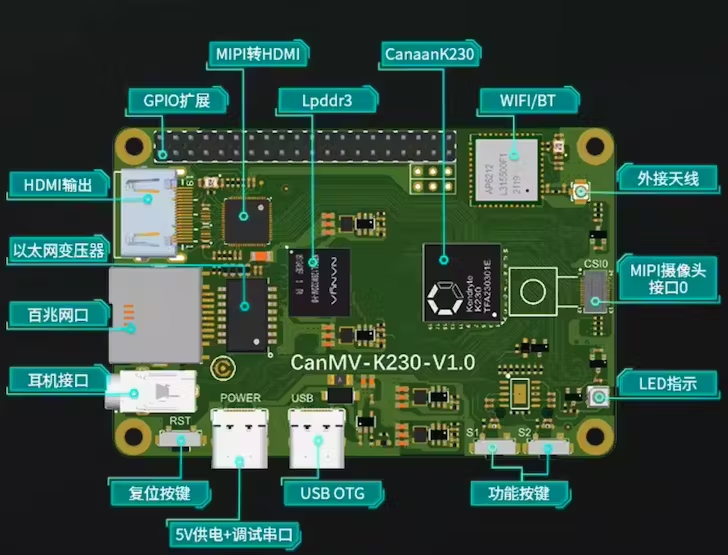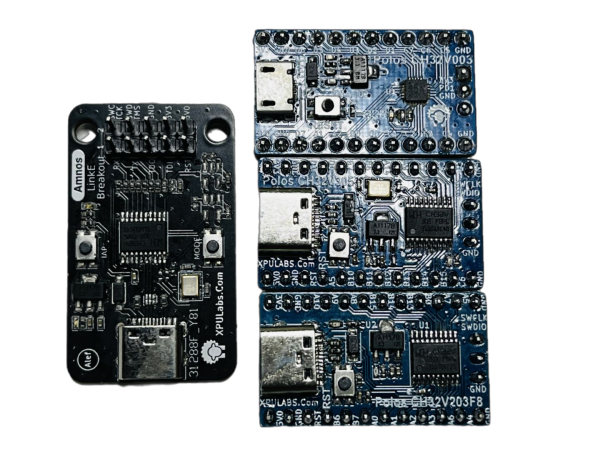-
Kendryte K230 RISC-V64 Board - CANMV-K230
10/23/2023 at 04:52 • 0 commentsThe K230 chip is the latest generation SoC product in Canaan Technology's (NASDAQ: CAN) Kendryte® series of AIOT chips. The chip adopts a brand-new multi-heterogeneous unit acceleration computing architecture, integrates two RISC-V C908 computing cores, and has a built-in new generation KPU (Knowledge Process Unit) intelligent computing unit. Multi-precision AI computing power with INT8 and INT16. Supports general AI computing framework. The chip also has a variety of peripheral interfaces, as well as multiple scalar, vector, graphics, and other dedicated hardware acceleration units such as image 2D engine, AI 2D engine, 2.5D GPU, and 3D depth engine. K230 provides full-process computing acceleration for various computing tasks such as images, videos, audio, AI, etc. The chip has many features such as low latency, high performance, low power consumption, fast startup, and high security. K230 can be used in various smart hardware products, such as smart door locks, home smart security cameras, dictionary pens, payment recognition, 3D structured light vision modules, drones, interactive robots, smart home appliances, smart toys, and smart manufacturing, intelligent vehicle cockpit and many other fields.
![]()
![]()
CanMV-K230 Board Features
- CPU: core1 - 64bit, RISC-V processor, 1.6GHz, supports RISC-V Vector Extension 1.0 specification with FPU, VPU; core0 - 64bit, RISC-V processor, 800MHz, supports RISC-V 64GCB instruction set;
- KPU: Support INT8 and INT16, TVM / TensorFlow / Pytorch / ONNX; Typical network performance: Resnet 50 ≥ 85fps @INT8; Mobilenet_v2 ≥ 670fps @INT8; YoloV5S ≥ 38fps @INT8;
- DPU: Using 3D structured light depth calculation; Typical performance is 1280*800@30fps
- VPU: Video encoding/decoding: H.264/H.265/JPEG/MJPEG, 4K@40fps/20fps
- Memory: 512MB DDR, TF Card Storage up to 1T, QSPI Flash
- Camera: 500M Camera *1, Max 3ch MIPI CSI input;
- Display: HDMI 1; MIPI DSI 1, Max 1920 * 1080@60fps
- USB: USB2.0 OTG * 1
- Ethernet: 100Mbps * 1
- Others: Audio Interface 1, Debug UART 2, I2C 4, PWM 5, GPIO * 29
- Board Size: 56 x 85mm
![]()
![]()
Development
https://github.com/kendryte/k230_docs
https://github.com/kendryte/k230_sdk
-
Amnos CH347T Breakout
07/10/2023 at 05:17 • 0 commentsAmnos CH347T Breakout
Overview
Amnos CH347T Breakout is developed by XPU Labs, a subsidiary of AnalogLamb.Com. CH347 is a high speed USB converter interface chip, can provide USB to UART, I2C, SPI, JTAG, GPIO functions. Amnos CH347T Breakout's size is 40x40mm. It supports USB to two UARTs, It is used to program ESP32, integrate esp32 auto-download circuit. And it is used to program Xilinx FPGA with USB to JTAG function. It can also program EEPROM or Flash with USB to I2C/SPI function.
![]()
Specifications
- USB2.0 high-speed device with a bandwidth of 480Mbps
- High-speed dual serial ports support up to 9Mbps baud rate
- Integrate ESP32 auto-download Function with USB to UART
- JTAG interface, 4-wire standard JTAG protocol, high-speed transmission, up to 60MHz
- Program Xilinx FPGA to RAM or FLASH with USB to JTAG
- I2C interface, can be used to operate EEPROM or various sensors
- SPI interface supports 2 chip selection signals, the highest frequency can reach 36MHz
- Several GPIOs can be used with USB to GPIO
- Size: 40 x 40 mm
Software Development
Documents
-
Amnos LinkE Breakout Board
07/10/2023 at 05:15 • 0 commentsAmnos LinkE Breakout
Amnos LinkE Breakout can be used for online debugging and downloading of WCH RISC-V MCU, and also for online debugging and downloading of ARM MCU with SWD/JTAG interface. It also comes with a serial port for easy debugging output.
![]()
Features
- Support 3.3V/5V dual power output
- Support USB to TTL serial port function
- Support RISC-V chip single/dual line download debugging
- Support ARM MCU with SWD/JTAG interface for downloading and debugging
- Support firmware auto-detection and upgrade
- 3.3V/5V output power supply controllable
- Red and blue LED indicators, easy to view the working status
- Support the upper computer one key to switch the working mode
Development Tools
User Manual: WCH-LinkUserManual-EN.PDF
WCH-Link Local Burning Tool: WCH-LinkUtility.ZIP
Integrated Development Environment (IDE): MounRiver Studio(MRS) -
Polos CH32VXX RISC-V Breakout Boards
07/10/2023 at 05:14 • 0 commentsPolos CH32VXX RISC-V Breakout Boards
CH32V Series MCUs are designed by Qinheng Microelectronics Co., Ltd., focuses on connectivity technology and microprocessor research and is an IC design company. CH32V Series MCUs are low-cost & powerful functions like BT, USB2.0/3.0, CAN, I2C, SPI, USB PD and so on. So we develop the Polos CH32Vxx RISC-V Breakout Boards. Qinheng Provide C/C++ SDK, Arduino Library, and MRS IDE. We perfer to use Embedded Rust, We will support Embedded Rust development in CH32Vxx RISC-V MCU.
![]()
Polos CH32V003 Breakout Alef - Features
- Main Chip Type: CH32V003F4U6 with QFN20 Package
- QingKe 32-bit RISC-V2A processor, Up to 48MHz frequency
- 2KB SRAM, 16KB Flash, 3.3/5V Power Supply
- 1 ch DMA, 1 group of OP Amp, 1 group of 10-bit ADC
- 16 bit timer x 2
- USARTx1, I2Cx1, SPIx1
- 18 I/O ports, mapping an external interrupt
- 64-bit chip unique ID
- 1-wire serial debug interface (SDI)
Polos CH32V203F8 Breakout Alef - Features
- Main Chip Type: CH32V203F8P6 with TSSOP20 Package
- Qingke V4B, up to 144MHz frequency
- 20KB SRAM, 64KB Flash, 3.3/2.5V Power Supply
- Low-power modes: sleep/stop/standby
- Down to 44.65uA/MHz in Run mode
- Down to 17.90uA/MHz in Sleep mode
- 1 x 18ch DMA, 2xOP Amps, 2 x 9ch 12-bit ADC
- 1xUSB2.0 FS H/D
- USARTx2, I2Cx1, SPIx1
- 17 I/O ports, mapping 16 external interrupt
- CRC calculation unit, 96-bit unique ID
- Serial 2-wire debug interface
Polos CH32V305 Breakout Alef - Feautres
- Main Chip Type: CH32V305FBP6 with TSSOP20 Package
- Qingke V4F, up to 144MHz frequency
- 32KB SRAM, 128KB Flash, 3.3/2.5V Power Supply
- Low-power modes: sleep/stop/standby
- 2 x 9ch DMA, 1x12 bit DAC, 2 x 1ch 12-bit ADC
- 1xUSB2.0 HS H/D
- USARTx2, I2Cx1, SPIx1
- CANx1
- Timerx8
- Touch Key x1
- 17 I/O ports, mapping 16 external interrupt
- CRC calculation unit, 96-bit unique ID
- Serial 2-wire debug interface
-
Maple ESP32 Mini Board - ESP32-PICO-D4 Chip Inside
03/03/2018 at 03:59 • 0 commentsTest.
Test

Abraham's pages
Maker, Sunday School Teacher, Make and Write Content for ESP32, nRF52 & IoT and so on. http://www.analoglamb.com







